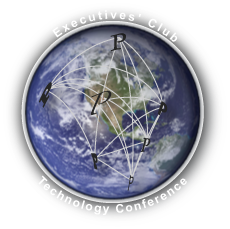Three CIOs Share Vision and Techniques for Creating the Networked Enterprise—Facebook and Tagging Creep In
 After James Owens’ luncheon address, the Executives’ Club of Chicago’s 2007-08 Technology Conference series opened with the CIO of the Year Award and a sneak preview of the 2008 Chicago Technology Outlook Survey.
After James Owens’ luncheon address, the Executives’ Club of Chicago’s 2007-08 Technology Conference series opened with the CIO of the Year Award and a sneak preview of the 2008 Chicago Technology Outlook Survey.
Then a diverse panel of executives took the stage to discuss the role of the CIO in the “networked economy 2.0.” Bahman Koohestani, Senior Vice President & Chief Information Officer, Orbitz Worldwide, Paul Mankiewich, Chief Technology Officer, Alcatel-Lucent and Karenann Terrell, Chief Information Officer, Baxter International, shared their visions for the evolving role of the CIO and IT. John Gentry, Partner and Managing Director, CSC Consulting, moderated the panel discussion with aplomb. The Club’s quarterly Technology Conference took place October 16 at the Chicago Hilton.
Although the panel represented such diverse businesses as pharmaceutical giant Baxter, global network equipment provider Alcatel-Lucent and travel sensation Orbitz, all were very focused on how CIOs needed to enable a new level of innovation by fostering a new level of trust and adopting a networked model—for everything. That means shared risk taking and trusting people.
Although their remarks had an appropriate enterprise focus, in Analysis and Conclusions, I will take the argument into the customer arena: only by extending their trust to customers will enterprises realize sustainable innovation in the long term.
The Executives’ Club of Chicago/AITP CIO of the Year Award
Patricia Morrison, Executive Vice President and CIO of Motorola, Inc., was recognized as the CIO of the Year. Each year, the Executives’ Club of Chicago and the Association of IT Professionals interview dozens of candidates, and presenters emphasized that this year’s competition was “the stiffest ever.”
2008 Chicago Technology Outlook Survey
 John Gentry had the honor of giving the audience a preview of The Executives’ Club of Chicago/CSC 2008 technology survey, in which they query technology executives about their plans for IT investment in the year ahead. Full results will be released in January 2008. Here are the highlights:
John Gentry had the honor of giving the audience a preview of The Executives’ Club of Chicago/CSC 2008 technology survey, in which they query technology executives about their plans for IT investment in the year ahead. Full results will be released in January 2008. Here are the highlights:
- IT’s stature increased in importance within the corporate sphere: 50% of respondents had a CIO and 50% of CIOs reported directly to their CEOs.
- The number one required change in IT was to centralize and standardize IT.
- CIOs’ most important focus was making business process number one, and sales would garner the lion’s share of IT investment.
- Web services was the number one technology (interest) for the third year running, followed by business intelligence for 2008. RFID and grid computing had the least interest.
- 51% of respondents’ staffing will be sourced internally (rather than outsourcing).
- 49% will have blogs and wikis operational in 2008.
- 30% have a green strategy.
- Gaining in importance this year will be: innovation (44%), accelerating business innovation (34%), integration with customers (34%) and business/IT alignment (36%). Multiple responses were allowed.
- For more information, please contact the survey team.
These findings clearly reflect the rising importance of innovation and revenue. However, as I have written extensively, this is not “your father’s innovation“: in the past, the “innovation cycle” would come and go every five years. In the Knowledge Economy, innovation is the cornerstone of value creation. Efficiency is merely expected; it will provide decreasing differentiation in the years ahead.
Bahman Koohestani, Senior Vice President & Chief Information Officer, Orbitz Worldwide
 Networked applications represent a completely different world for corporations and “IT.” There is a fundamental shift away from enterprise- and function-centric applications toward the (collaboration of networked components that function as an application). The old IT would design to specification and, if something didn’t work, well, that was not IT’s fault. Customers respond rapidly to the predictability and reliability of the experiences we deliver through networked applications. The old IT mantra, “It’s not our fault,” isn’t relevant because customer experience is what counts. It’s not always obvious what isn’t working in the networked environment . We must manage the process end to end; there’s no room for “us and them” anymore.
Networked applications represent a completely different world for corporations and “IT.” There is a fundamental shift away from enterprise- and function-centric applications toward the (collaboration of networked components that function as an application). The old IT would design to specification and, if something didn’t work, well, that was not IT’s fault. Customers respond rapidly to the predictability and reliability of the experiences we deliver through networked applications. The old IT mantra, “It’s not our fault,” isn’t relevant because customer experience is what counts. It’s not always obvious what isn’t working in the networked environment . We must manage the process end to end; there’s no room for “us and them” anymore.
Orbitz is only as strong as its weakest link, which drives the customer’s perception of quality. Business intelligence is a competency and suite of tools that Gartner calls “the last competitive advantage frontier” (the context here, I believe, was enterprise applications). Application availability is critical, as is connectivity. Barriers to competition are far lower in the networked environment, where Ajax, RSS and REST reign. Facebook applications are the future; Koohestani referenced the recent sale of a Facebook travel application for $10 million.
- The value of the Internet and Web 2.0 is that they enable communities to form, and e-business monetizes social communities. Facebook applications deliver value to the community.
- The boundaries between supply and demand have dissolved. Now customers create products, and demand is supply because consumers create, sell and promote brands in the networked environment. (Many Facebook apps are developed by customers.)
- The application architecture is now explicitly an ecosystem. Orbitz leverages open source heavily. when you buy software, you buy talent, and open source has more talent and delivers more value. Orbitz applies open source ways of thinking and procedures internally.
- Social networking demands a new kind of leadership, more transparency, no hierarchies. You need to listen to the people. Orbitz uses wikis extensively; wikis enable the right talent to emerge.
- The U.S. government makes it very difficult to be competitive due to immigration restrictions; talent is global (and companies need to be able to manage and move people globally). Orbitz has 350 people in India.
- As companies grow in size, they have an increased management burden, and this can be lethal in IT if not managed appropriately. The talent that builds things usually has no interest in maintenance, and they leave. Orbitz handles that by spinning off ventures and letting creative people run with their ideas. Koohestani cited examples of Chacha (Bezos) and 43 things (amazon.com roots). You have to keep their emotional investment high. Having a cost focus will drive people away.
- There are many myths about innovation. The most important thing is not having creative people, it’s knowing the customer and maintaining a business model focus (rather than technology for technology’s sake). You need people to focus on the customer and operationalize processes. You also need a smooth process for handing off innovations to people who like to manage and maintain.
- Succeeding in the networked economy requires an ecosystem focus and leaders who are more transparent and collaborative, who share ownership. CIOs must trust the community and be emotionally invested.
Paul Mankiewich, Chief Technology Officer, Alcatel-Lucent
 Mankiewich is the self-described plumber of the distributed, networked environment, and he loves it because global networks need require constant investment and enhancements, which drives his business. Video is growing steadily: YouTube is responsible for 25% of the Internet’s http traffic and 10% of its total traffic. MySpace is a trove of UGC (user-generated content) that is growing 200%. Cable is losing control over video as more shows are opting to post episodes on the Internet. Most TV is time shifted (not watched when programmed; TiVO’ed).
Mankiewich is the self-described plumber of the distributed, networked environment, and he loves it because global networks need require constant investment and enhancements, which drives his business. Video is growing steadily: YouTube is responsible for 25% of the Internet’s http traffic and 10% of its total traffic. MySpace is a trove of UGC (user-generated content) that is growing 200%. Cable is losing control over video as more shows are opting to post episodes on the Internet. Most TV is time shifted (not watched when programmed; TiVO’ed).
Technologies are overlaid on each other (which increases capability and complexity). At this point, providers are bundling existing services (local phone, Internet, cable and cellular), but the value is far higher when these are converged. For example, a CIO is watching a show at home when she realizes that it’s time for the video conference call to China. Currently, she has to go upstairs to the office. It would be far better to be able to participate in the call from anywhere, to use the TV monitor if appropriate, to bring the conference bridge up from anywhere, or to have the call hand off seamlessly to mobile if that’s what the customer wants. Blended home entertainment is Alcatel-Lucent’s mantra.
The device is still regarded as a “phone,” but that way of thinking is old-fashioned. It is a personal device that can be configured to access any kind of service. It’s not even limited to communications anymore, as entertainment and social computing are increasingly the focus.
- Alcatel-Lucent has a service arm that manages clients’ infrastructure, end to end. That’s a core competency. Will Google own its network? (no). There are thousands of providers in the network (ecosystem), and managing the network means managing relationships.
- The ecosystem is the killer environment, but how to create it? We’re not good at sharing. Emails are hated but they are useful.
- Alcatel-Lucent has flattened considerably; everyone uses wikis and blogs. But (software) products still have millions of lines of code; and they are written all over the world, which is very difficult to manage. We aren’t as efficient as we need to be. But competitors aren’t either. We have twenty development centers around the world working on (software) products.
- Security is a big issue. People like to try things out, but they breach security while innovating. About one half of employees work from home some of the time.
- The (IT) ivory tower is a remnant of the past. CIOs must innovate in business areas. For example, although there is a strong technology component to Google, the real innovation is how the ads work; CIOs must adopt an external focus and break down silos (to increase collaboration). Acquire start-ups to bring innovation into the enterprise.
- A critical success factor for CIOs is to embrace change and maintain flexibility. Modify processes and look everywhere for inspiration. Things are changing faster than ever, employees’ capabilities change daily.
Karenann Terrell, Chief Information Officer, Baxter International Inc
 Terrell spoke passionately about how CIOs had to adopt network thinking in terms of people: to succeed in this environment, CIOs must create collaborative, networked teams. She recently came to Baxter from the automotive sector (Chrysler et al), and she’s been busy “replatforming” IT at Baxter. Everyone is new or has a new job. “CIOs have lousy jobs,” she remarked, when they don’t understand how to partner and collaborate at every level and in every way. The CIO role is constantly evolving. Now it has far more to do with business and human resources, with technology taking more of a back seat. Moreover, domain knowledge is the key to getting and keeping your place at the (boardroom) table. Therefore, think of yourself as a business executive (don’t hide behind IT knowledge).
Terrell spoke passionately about how CIOs had to adopt network thinking in terms of people: to succeed in this environment, CIOs must create collaborative, networked teams. She recently came to Baxter from the automotive sector (Chrysler et al), and she’s been busy “replatforming” IT at Baxter. Everyone is new or has a new job. “CIOs have lousy jobs,” she remarked, when they don’t understand how to partner and collaborate at every level and in every way. The CIO role is constantly evolving. Now it has far more to do with business and human resources, with technology taking more of a back seat. Moreover, domain knowledge is the key to getting and keeping your place at the (boardroom) table. Therefore, think of yourself as a business executive (don’t hide behind IT knowledge).
Baxter has a shallow bench of people, but this is part of the plan. In the networked economy, relationships are networked. Terrell has a teenage son, and she sees how Web 2.0 is affecting the emerging workforce. Young workers have high expectations, and the baby bust is strengthening their hand. They won’t want to work in corporations; rather, the action will be with technology companies like IBM, Microsoft and Cisco, not corporate IT (plus ça change ,^).
Under her leadership, Baxter has transformed its attitudes and approaches
with “vendors,” whom it regards as partners today. Out with “vendor management” and “trusted advisor,” in with co-creating roadmaps and sitting at the table together. The “vendor” preoccupation with sales goes away because you are co-creating. There is a different level of trust. This is critical because technology specialists can do it better; it’s what they do. This only works if you drop the “dance with vendors.” Be more open and honest, even though it’s hard to unlearn old ways. Baxter is a science and pharmaceutical development and marketing company; IT is only an enabler. She’s been through this at Chrysler; they spun off a paint division so that it could specialize and manage talent better.
- CIOs must change the IT mentality—away from finger-pointing, toward more collaboration. There is so much change among employees and vendor-partners that no one knows who does what. Baxter is breaking down silos to enable collaboration.
- The old way was to “manage to plan,” but we have a new approach now. We think, “How can we solve it?” rather than “Whose problem is it?”
- Employer brands are less important these days. Today’s talent expects to have ten to twenty jobs. CIOs must change the model; the enterprise needs some stability, but plan for mobility. Let people run with it, give them room, and plan for defections, which will be the rule, not the exception.
- People are attracted to the work and their coworkers, not the hierarchy. They are also attracted to leaders, the passion and energy of their coworkers, which becomes a virtuous circle if the CIO can create it. Implied is that this generation could care less about “climbing the ladder.” In other words, they are network-centric, not hierarchy-focused.
- At Baxter, science and technology innovation is the value-add. Web 2.0 and the networked economy is where it can excel, but that requires a transformation in thinking. The next blockbuster will probably not be invented at Baxter—but will be taken to market by Baxter.
- Biotech and medical research are now equivalent to (Silicon) Valley garages, and innovation emerges from everywhere, university labs, too. Baxter excels at packaging, commercializing and marketing. It has huge budgets and must partner with outsiders, must help them to do business. Baxter must de-perimeterize and be more approachable.
- The old way was to jealously hoard all the knowledge in Round Lake. The brilliant scientists were all there. Now they work with scientists in Shanghai and Vietnam, all over the world (collaboration is the value-add, not absolute knowledge or technique).
- Technology can unify these dispersed teams and, if CIOs do their jobs right, the technology disappears (because it becomes so transparent, it no longer draws attention to itself).
- Facebook is cool; no one thinks about the technology. It’s the way that the Web 2.0 workforce collaborates. Even though it represents security issues, it’s how they work. Second Life is also a challenge, as is China collaboration (IP issue?) and wikis (everything online and can be compromised). CIOs need to provide security and collaboration. Innovation happens in pockets. CIOs need to protect while being open.
- Innovation is situation and time dependent. Top scientists innovate, but probably even more ideas will emerge from the common man.
- The average CIO tenure is three years. Knowing how to manage risk is the only thing that makes you part of the solution, rather than the problem.
Analysis and Conclusions
Innovation
 Conclusions of the panel paralleled the results of the 2008 Chicago Technology Outlook Survey: innovation is widely seen (hoped?) as the way to drive revenue and value.
Conclusions of the panel paralleled the results of the 2008 Chicago Technology Outlook Survey: innovation is widely seen (hoped?) as the way to drive revenue and value.- However, “white coat” innovation has a whopping 4% success rate (Doblin); a new, more open model is clearly needed, as I share below. Panelists’ remarks about IT are readily applicable to product development, marketing and customer service. For more on this, see Consumer Empowerment: Rare Opportunity for Innovation.
- Facebook is the future for many reasons. Its architecture permits fast-cycle, iterative, emergent innovation. Creators mash up all kinds of concepts. It’s a lab with a market. Facebook itself provides a community, but customers create widgets that they offer to the community. This is emergent innovation: no one in the ivory tower does focus groups and decides what direction application development will go (although Facebook does provide technology boundaries and basic standards, of course). Customers introduce widgets. It the crowd likes them, competitors emerge. If not, they die quickly. The system is inherently social, and customers get what they want—consistently.
- Threadless is another brilliant example of open customer collaboration: customers submit their designs to the Website, other customers vote on them, and the winners are made into clothing. When you abstract away from the B2C context, you can see that this is widely applicable in B2B. The art is knowing how to mix the right company experts into the social space and teach them how to collaborate with diverse groups of people.
- Terrell’s poignant remarks about the challenge of getting IT to be more collaborative are equally applicable to marketing. Marketers are accustomed to “owning the message” as well as product development (in many companies). The problem today is that customers don’t always agree, and Web 2.0 (blogs, YouTube, wikis) gives them a megaphone to say so. Marketers also have legacy thinking and need to learn the same lessons.
- CIOs can widely harness the collaborative, social facet of Facebook by aggressively introducing tagging—to the enterprise and to partners and customers. Tagging enables everybody to identify and add value to content, using standardized messaging (tags). For more, see Social Tagging, Changing the Economics of E-Commerce (although the title has a B2C tone, it is imminently applicable to B2B).
- For a B2B take on innovation featuring Dell and Procter & Gamble executives, see Always in Beta: How big Business Can Benefit from “Little” Innovation.
- The network Zeitgeist spreads broad and deep; even war, whence the large bureaucratic organization came, has gone the way of the network (guerilla).
- Another part of the network phenomenon is the concept of mashing things up and iteration. Koohestani didn’t mention this explicitly, but open source enables people to try things and have rapid feedback from the crowd, which is incredibly efficient. This is iteration: gone is the concept that you get you plan perfect: even if this were possible, the market would have moved (and invalidated many of your planning assumptions) by the time you would have finished. Iteration applies flexible processes and improves over time. Mashing up means tinkering and connecting things that aren’t normally connected. These concepts have wide applicability in the networked economy, and they are only now emerging. Watch for them and practice them.
The Role of the CIO
 The panelists clearly agreed that the CIO’s most important role was to facilitate profound IT transformation—not in terms of technology, but people, attitude and outlook. This was a superb panel because, although the thesis was clear and consistent, each panelist had a complementary view: Koohestani enables an e-commerce business, so he is very focused on applications that define experience. Mankiewich emphasized the network itself—the network that transcends organization—it is his business. Terrell is a visionary CIO who is explicitly transforming “enterprise IT” within a business whose processes she supports.
The panelists clearly agreed that the CIO’s most important role was to facilitate profound IT transformation—not in terms of technology, but people, attitude and outlook. This was a superb panel because, although the thesis was clear and consistent, each panelist had a complementary view: Koohestani enables an e-commerce business, so he is very focused on applications that define experience. Mankiewich emphasized the network itself—the network that transcends organization—it is his business. Terrell is a visionary CIO who is explicitly transforming “enterprise IT” within a business whose processes she supports.- Networked structures are pervading all aspects of the enterprise: Koohestani and Mankiewich both pointed out that technology itself was networked, but people have to catch up. It’s easy to say that silos should be dismantled, but that has to be accomplished with a deft hand. Operationally, all panelists advised adopting more of an external focus. Opening up the enterprise is an effective way to iterate transformation.
- Koohestani emphasized the people element of development, but the people transformation was the cornerstone of Terrell’s remarks. She is clearly recreating the IT environment and culture, within Baxter and its external ecosystem.
- Mankiewich’s remarks gave me flashbacks to Digital Hollywood. Read the report on telecoms transformation. If you are interested in the transformation of the mobile device, read the report on mobile transformation.
- All panelists remarked that the networked environment increased complexity, risk and angst. I predict that this will persist until people understand the principle of encapsulation. IT as a culture has too often interacted and delegated poorly. The networked environment means that independent people voluntarily collaborate and recognize interdependencies.
- To borrow a software metaphor: in object-oriented software, objects are components of code that perform services, but the way they do their jobs is invisible to other objects (“encapsulated”); the only thing objects have to know is how to request services and to respond to requests. This is possible with standardized messaging.
- When you think about it, the lack of standardized messaging is where most collaboration problems occur (“expectations”). Much problem-solving is required to make sure that understanding is mutual.
- To the speakers’ credit, none spoke about “business/IT alignment,” which reflects Enterprise 1.0 thinking. Enterprise 2.0 thinking focuses on customer/company alignment by collaborating with customers to service customers, create new offers and in general. Here is a B2B view on enterprise 2.0.

Thank you for the concise and insightful summary of this event. On the one hand, many of the comments made by the expert panel came as little surprise as the strategic imperatives for IT have become readily apparent in the past year or so, but on the other hand I found the nods to Facebook to be somewhat surprising. Web 2.0 is definitely on the radar for most CIO’s, but the profound impact of the platform on the traditional IT model has yet to be defined. I have to admit that I ignored Facebook for several years because of my disappointment with mySpace – a tool for teenagers and indie rock bands – but after finally caving in to the buzz and creating a Facebook account, I found the breadth of the tool to be immediately noticeable and intuitive. The more I explore the applications that are being created for the platform, the more I can envision the power of Facebook; and the multi-dimensional social networking paradigm (essentially a “network of networks”) is where Facebook stands apart from the “flat” networking platforms such as mySpace and LinkedIn. That being said, my hope is that CIO’s realize the importance of the powerful collaboration and relationship building possibilities that Facebook brings to the table and embrace the platform rather than take the traditional IT path of shunning technologies that fall outside the immediate span of control of the internal organization. As a community, we need to define the value that Facebook brings to the table and explore the linkages between businesses and customers that will ultimately tear down the walls between closed networks and bring people together in ways that could not have been imagined just 5 years ago. This is not only a tremendous business opportunity in itself, but a launching pad for IT to leverage an emerging technology and demonstrate the ability to innovate and recognize strategic opportunities that will restore the credibility of the function in the eyes of company leadership.
your articles on human capital are thought provoking. i love to visit your website frequently to read recent updates.
[…] Innovation Defines New CIO Role at “Networked Economy 2.0″ Conference delves into the CIO’s role in preparing the enterprise to engage customers in the Web 2.0 world. […]
[…] post Innovation Defines New CIO Role at Executives’ Club “Networked Economy 2.0″ Techno… appeared first on Christopher S. Rollyson and […]